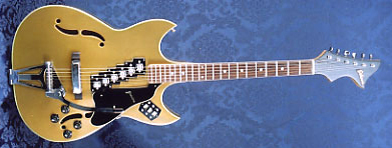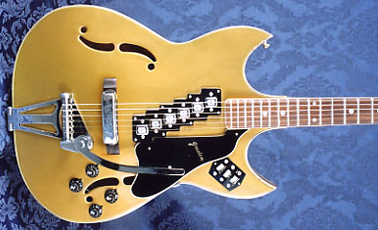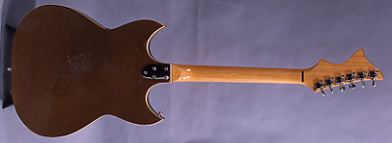People who aren’t hooked on guitars are probably not aware of the medical fact that guitar lovers can be highly susceptible to whiplash. I still get a pain in my neck when I remember the first time I saw this Sekova Grecian calling to me from the back of the rack at MusicCity in Newark, NJ, like some sensuous, mythical Siren. You’re walking by glancing at the wall of guitars and your head snaps around as you yell, “What the hell?”

1968 Sekova Grecian Electric Guitar
MusicCity at the time I found it, by the way, was known to a select few as the first Temple of Doom. Sitting on the edge of a down-at-the-heels downtown, it had once been a large regional musical distributor. It had four stories, the upper floors of which were loaded with dusty, unsold new-old-stock musical gear, some going back three or four decades. New, in-the-box ’60s Kapa guitars and ’70s Maestro pedal effects were among the treasures I pulled off the rough plank wood shelves.

1968 Sekova Grecian Electric Guitar
Not much is known about Sekova guitars. They were imported from Japan by U.S. Musical Merchandise of New York City, one of many music distributors that once thrived in that fair city. Who actually made Sekovas in Japan also remains a mystery, but it’s similar to a Greco 921. Greco. Grecian. Geddit? Many, if not all, Grecos were built by the great Fuji Gen Gakki factory, the company that made most classic Ibanez guitars, so perhaps that’s where this originated. The aesthetics of this exotic beast probably place it from around 1968 or possibly slightly earlier. Both the fish-fin headstock, a Kay knockoff, and the gold finish would be plenty enough to do damage to your neck muscles (a lot of these have turned green with time), but the real clincher is the pickup system. Now, a lot of guitar designers have played around with pickup placement. Some tilt the neck pickup backward on the bass side. Others tilt it forward. Some have even used individual poles and coils for each pickup, but no one has come up with such a novel layout as the Sekova Grecian! I can’t say there wasn’t a lot of scientific measurement of frequency response to determine the placement of these units, but I suspect it was more like one of those “Wouldn’t it look cool if” kinds of decisions!

1968 Sekova Grecian Electric Guitar
In fact, the electronics were designed to give a kind of stereo effect, with the three bass pickups controlled by the Mic 1 switch and the treble by Mic 2, with a Mix switch (all), put out through a stereo jack.

1968 Sekova Grecian Electric Guitar
Whether or not there was method to this madness, it didn’t work. As cool as it looks, this Grecian formula sucks big time. The stereo idea wasn’t terrible, but you always had to have two amps to take advantage of it. Plus, the coils are just not big enough to crank out much sound and, like so many Japanese guitars from this era, the wiring is extremely thin and the pots are crummy, so you’re lucky if the thing plays. That being said, the Sekova Grecian is still a boss guitar. Once you strap it on, it’s sure to turn heads, so you can share the whiplash!

There was one mention on the web of a guitar designer named Peter Sekova, but I can’t find it now. I assume he’s the one who lent his name to these instruments. Some of them must have been built by Kawai-Teisco, judging from the distinctive rounded-rectangle fretboard markers. Sekova-branded classical guitars were imported from Brazil, AFAIK.
I have an acoustic guitar that I bought at a pawn shop that said Sakova on the head stock. Would like to ask if anyone knows were on the web I can find more info. Thanks.
Zeke
hey all i have a sekova acuostic passed down to me from my dad he got it from my grandfather when he was 18 so i estimate mine to be about 45 yrs old as i understand it they were called japan gibsons because the parts were made by gibson and put togather in japan under the name sekova thats all i know as far as a value i cant find anything to confirm a value the pawn shops if pawning the best you can get is about 40.00 so i guess it could be worth atleast a 100.00
I have a Sekova guitar and it is beautiful. And I looked up Sekova guitars on google to see if I can find one that looked like it and I couldn’t fund any that did. The man that gave it to my mom when she was little asked for it back because he realized it was worth a lot of money but she didn’t give it back. So I was wondering of it was rare. Is there a way of knowing or finding out? It is orange and has paint splatters that are hand painted you can feel it. The neck is black with a green tint. Does that mean anything? i don’t know??
So I have a les paul copy bass. The “black beauty”. Original owner picked it up in the early 70’s. I’m having trouble finding any info on it but have the serial number. It’s absolutely wonderful sound comes from pickups I’ve never seen anything like before. Serial number is 1057659. Any help to identify mfg date would be appreciated.
My first bass was a Sekova Hofner 500/X copy, cherry burst w/ black, bought in 1990 or 1989 maybe. The original pickups failed, so I placed EMG bass humbuckers on it. I’ve
even used it on many home recordings over the years. I still have it, but now it’s
fretless. I liked it’s hollow sound, but had to be careful using it on my brother’s bass amp, which was a mid ’60s Fender Bassman. I still have the original pickups and do plan to rewind them, but as compact ‘buckers.
I have a Sekova acoustic 12 model FJ-2 Anyone know the production years?
I have an Autoharp that needs repairing. All parts are present but a plastic part broke. Can you replace it and reattach the chord bars in place?
I have a Sekova Custom 6 string electric Les Paul style. I can’t seem to find anything on these either . If Anybody knows anything about this model Would love to hear from you . I know it’s a mid 60’s model for sure and have been told it is worth quite a bit. Just looking for more information
My best freind and stationed Korea in the good old days. Mine was 78 to 83. His was 77 to 82 i think. We were playing korean guitars for a few days at a time then buying new ones cuz yes they were that bad. He my friend got hold of one that lasted and had tone. It was a Sekova. Acoustic guitar made in Korea. Well guitars were great and still are the love of both our lives cept we do long distance sharing now as i live on Long Beach Peninsula WA with the lady i met back then and he lives in Arizona with his lady from those days. After years of playing guitar my friend is winding pups and he will wind the best im certain. The pups on this guitar are why im here. Very cool guitar lucky find and good on recognizing it and keeping it.
In ’75 my friend Paul had a black Sekova Les Paul custom model played through a Gibson SG Systems guitar amp. I played it and the heft and action were spot-on to a true LP. Seems that at the time Sekova knock-offs were the best of the import models. Last week I missed a deal on a Sekova EB-3 bass. That was the droid I was looking for!
Thanks very interesting article learned allot . Thank you
Great article. Thank you
hey, i have what im sure is a 60’s sekova japan off white model and im trying to find out how much its worth. its a semi hollow body electric and workes perfectly thanks